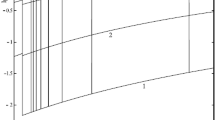Abstract
The Neupert effect is the name given to the correlation observed in many flares between the time-integrated microwave and hard X-ray emissions and the soft X-ray emission light curve. We have used hard X-ray data from the Hard X-Ray Burst Spectrometer (HXRBS) on the Solar Maximum Mission (SMM) and soft X-ray data from the detector on GOES to determine what fraction of all events show this correlation and how the correlation changes from the impulsive to the gradual phase. We have found that of 66 HXRBS events observed in 1980 with a peak rate of > 1000 counts s-1, 58 (80%) showed good correlations with peaks in the GOES time derivative plot corresponding to peaks in the hard X-ray (HXR) plots to within ±20 s. In 20 of these good-correlation cases (30%), the soft X-ray (SXR) time derivative stays high after the HXR emission has decreased suggesting that the later emissions result from energy release in a loop already affected by the initial energy release. In 8 of the 13 flares that showed poor correlation, the SXR time derivative shows no peak corresponding to the initial HXR impulsive peak that has structure on a time scale of ≤ 1 s. This suggests that in these events the initial impulsive energy release results primarily in electron acceleration, and that the secondary plasma heating from the accelerated electrons contributes relatively little compared to the more gradual plasma heating already taking place at the same time. The more gradually varying events, commonly referred to as type C flares, tend to show poorer correlation between the SXR time derivative and the HXR time profile. Of 26 GOES X1 or greater flares recorded between 1980 and 1989 with HXR peaks lasting over 10 rain, 13 (50%) showed poor correlation with the gradual HXR peaks either not registering at all in the SXR time derivative plots or showing up as very broad peaks. In one case, on 1981 April 26, the SXR time derivative peak was delayed by 13 rain. Only 17 (65%) of the 26 X-flares had an earlier, impulsive component and of those, 12 (71%) showed good correlation between the impulsive peaks.
Similar content being viewed by others
References
Benka, S. G.: 1991, Ph.D. thesis, University of North Carolina at Chapel Hill, also published as NASA TM 4323.
Brown, J. C.: 1971,Solar Phys. 18, 489.
Cliver, E. W., Dennis, B. R., Kiplinger, A. L., Kane, S. R., Neidig, D. F., Sheeley, N. R., Jr., and Koomen, M. J.: 1986,Astrophys. J. 305, 920.
Datlowe, D. W.: 1975, in S. R. Kane (ed.), ‘Solar Gamma-, X-, and EUV Radiation’,IAU Symp. 68, 191.
Datlowe, D. W., Elcan, M. J., and Hudson, H. S.: 1974,Solar Phys. 39, 155.
Dennis, B. R.: 1988,Solar Phys. 118, 49.
Dennis, B. R.: 1991, in Y. Uchida, R. C. Canfield, T. Watanabe, and E. Hiei (eds.),Lecture Notes in Physics 387, 89.
Dennis, B. R., Uberall, B. M., and Zarro, D. M.: 1991, ‘Proc. IAU Colloq. No. 133 on Eruptive Solar Flares, Iguazu Falls, Argentina’,Lecture Notes in Physics 399, 139.
Dennis, B. R., Orwig, L. E., Kennard, G. S., Labow, G. J., Schwartz, R. A., Shaver, A. R., and Tolbert, A. K.: 1991,The Complete Hard X-Ray Burst Spectrometer Event Listing, 1980–1989, NASA TM 4332.
Emslie, A. G., Li, P., and Mariska, J. T.: 1992,Astrophys. J. 399, 714.
Feldman, U.: 1990,Astrophys. J. 364, 322.
Feldman, U., Cheng, C-C., and Doschek, G. A.: 1982,Astrophys. J. 255, 320.
Hudson, H. S.: 1991,Bull. Am. Astron. Soc. 23, 1064.
Holman, G. D.: 1985,Astrophys. J. 293, 584.
Li, P., Emslie, A. G., and Mariska, J. T.: 1989,Astrophys. J. 341, 1075.
Mariska, J. T., Emslie, A. G., and Li, P.: 1989,Astrophys. J. 341, 1067.
Neupert, W. M.: 1968,Astrophys. J. 153, L59.
Nitta, N., Dennis, B. R., and Kiplinger, A. L.: 1990,Astrophys. J. 353, 313.
Orwig, L. E., Frost, K. J., and Dennis, B. R.: 1980,Solar Phys. 65, 25.
Speich, D. M., Nelson, J. J., Licata, J. P., and Tolbert, A. K.: 1991,The 1980 Solar Maximum Mission Event Listing, NASA TM 4287.
Starr, R., Heindl, W. A., Crannell, C. J., Thomas, R. J., Batchelor, D. A., and Magun, A.: 1988,Astrophys. J. 329, 967.
Strong, K. T., Benz, A. O., Dennis, B. R., Leibacher, J. W., Mewe, R., Poland, A. I., Schrijver, J., Simnett, G., Smith, J. B., Jr., and Sylwester, J.: 1984,Solar Phys. 91, 325.
Syrovatskii, S. I. and Shmeleva, O. P.: 1972,Soviet Astron.-AJ 16, 273.
Tanaka, K.: 1983, in P. B. Byrne and M. Rodono (eds.), ‘Activity in Red Dwarf Stars’,IAU Colloq. 71, 307.
Tanaka, K. and Zirin, H.: 1985,Astrophys. J. 299, 1036.
Tanaka, K., Nitta, N., and Watanabe, T.: 1982,Proc. Hinotori Symp. on Solar Flares, ISAS, Tokyo, p. 20.
Tsuneta, S.: 1983, in J. C. Pecker and Y. Uchida (eds.),Proc. Japan-France Seminar on Active Phenomena in the Outer Atmosphere of the Sun and Stars, p. 243.
Tsuneta, S., Takakura, T., Nitta, N., Ohki, K., Tanaka, K., Makishima, K., Murakami, T., and Oda, M.: 1984,Astrophys. J. 280, 887.
Wu, S. T., de Jager, C., Dennis, B. R., Hudson, H. S., Simnett, G. M., Strong, K. T., and 15 co-authors: 1986, in M. R. Kundu and B. E. Woodgate (eds.),Energetic Phenomena on the Sun, Ch. 5.
Author information
Authors and Affiliations
Rights and permissions
About this article
Cite this article
Dennis, B.R., Zarro, D.M. The Neupert effect: What can it tell us about the impulsive and gradual phases of solar flares?. Sol Phys 146, 177–190 (1993). https://doi.org/10.1007/BF00662178
Received:
Revised:
Issue Date:
DOI: https://doi.org/10.1007/BF00662178




